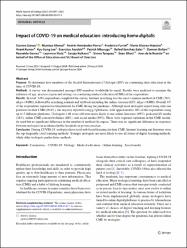| dc.contributor.author | Gravas, Stavros | |
| dc.contributor.author | Ahmad, Mümtaz | |
| dc.contributor.author | Hernandez-Porras, Andres | |
| dc.contributor.author | Furriel, Frederico | |
| dc.contributor.author | Alvarez-Maestro, Mario | |
| dc.contributor.author | Kumar, Anant | |
| dc.contributor.author | Lee, Kyu-Sung | |
| dc.contributor.author | Azodoh, Evaristus | |
| dc.contributor.author | Mburugu, Patrick | |
| dc.contributor.author | Sanchez-Salas, Rafael | |
| dc.contributor.author | Bolton, Damien | |
| dc.contributor.author | Gomez, Reynaldo | |
| dc.contributor.author | Klotz, Laurence | |
| dc.contributor.author | Kulkarni, Sanjay | |
| dc.contributor.author | Tanguay, Simon | |
| dc.contributor.author | Elliott, Sean | |
| dc.contributor.author | de la Rosette, Jean J. M. C. H. | |
| dc.date.accessioned | 2022-03-16T07:53:40Z | |
| dc.date.available | 2022-03-16T07:53:40Z | |
| dc.date.issued | 2021 | en_US |
| dc.identifier.citation | Gravas, S., Ahmad, M., Hernandez-Porras, A., Furriel, F., Alvarez-Maestro, M., Kumar, A. ... de la Rosette, J. J. M. C. H. (2021). Impact of COVID-19 on medical education: Introducinghomo digitalis. World Journal of Urology, 39(6), 1997-2003. https://doi.org/10.1007/s00345-020-03417-3 | en_US |
| dc.identifier.issn | 0724-4983 | |
| dc.identifier.issn | 1433-8726 | |
| dc.identifier.uri | https://doi.org/10.1007/s00345-020-03417-3 | |
| dc.identifier.uri | https://hdl.handle.net/20.500.12511/9122 | |
| dc.description.abstract | Purpose To determine how members of the Societe Internationale d'Urologie (SIU) are continuing their education in the time of COVID-19. Methods A survey was disseminated amongst SIU members worldwide by email. Results were analyzed to examine the influence of age, practice region and settings on continuing medical education (CME) of the respondents. Results In total, 2494 respondents completed the survey. Internet searching was the most common method of CME (76%; allps < 0.001), followed by searching journals and textbook including the online versions (62%; allps < 0.001). Overall, 6% of the respondents reported no time/interest for CME during the pandemic. Although most urologists report using only one platform for their CME (26.6%), the majority reported using >= 2 platforms, with approximately 10% of the respondents using up to 5 different platforms. Urologists < 40 years old were more likely to use online literature (69%), podcasts/AV media (38%), online CME courses/webinars (40%), and social media (39%). There were regional variations in the CME modality used but no significant difference in the number of methods by region. There was no significant difference in responses between urologists in academic/public hospitals or private practice. Conclusion During COVID-19, urologists have used web-based learning for their CME. Internet learning and literature were the top frequently cited learning methods. Younger urologists are more likely to use all forms of digital learning methods, while older urologists prefer fewer methods. | en_US |
| dc.language.iso | eng | en_US |
| dc.publisher | Springer | en_US |
| dc.rights | info:eu-repo/semantics/openAccess | en_US |
| dc.subject | COVID-19 | en_US |
| dc.subject | Coronavirus | en_US |
| dc.subject | Medical Education | en_US |
| dc.subject | Online Learning | en_US |
| dc.subject | Social Media | en_US |
| dc.subject | Urology | en_US |
| dc.title | Impact of COVID-19 on medical education: Introducinghomo digitalis | en_US |
| dc.type | article | en_US |
| dc.relation.ispartof | World Journal of Urology | en_US |
| dc.department | İstanbul Medipol Üniversitesi, Uluslararası Tıp Fakültesi, Cerrahi Tıp Bilimleri Bölümü, Üroloji Ana Bilim Dalı | en_US |
| dc.authorid | 0000-0002-6308-1763 | en_US |
| dc.identifier.volume | 39 | en_US |
| dc.identifier.issue | 6 | en_US |
| dc.identifier.startpage | 1997 | en_US |
| dc.identifier.endpage | 2003 | en_US |
| dc.relation.publicationcategory | Makale - Uluslararası Hakemli Dergi - Kurum Öğretim Elemanı | en_US |
| dc.identifier.doi | 10.1007/s00345-020-03417-3 | en_US |
| dc.institutionauthor | de la Rosette, Jean J. M. C. H. | |
| dc.identifier.wosquality | Q1 | en_US |
| dc.identifier.wos | 000563762200001 | en_US |
| dc.identifier.pmid | 32860535 | en_US |
| dc.identifier.scopusquality | Q1 | en_US |


















